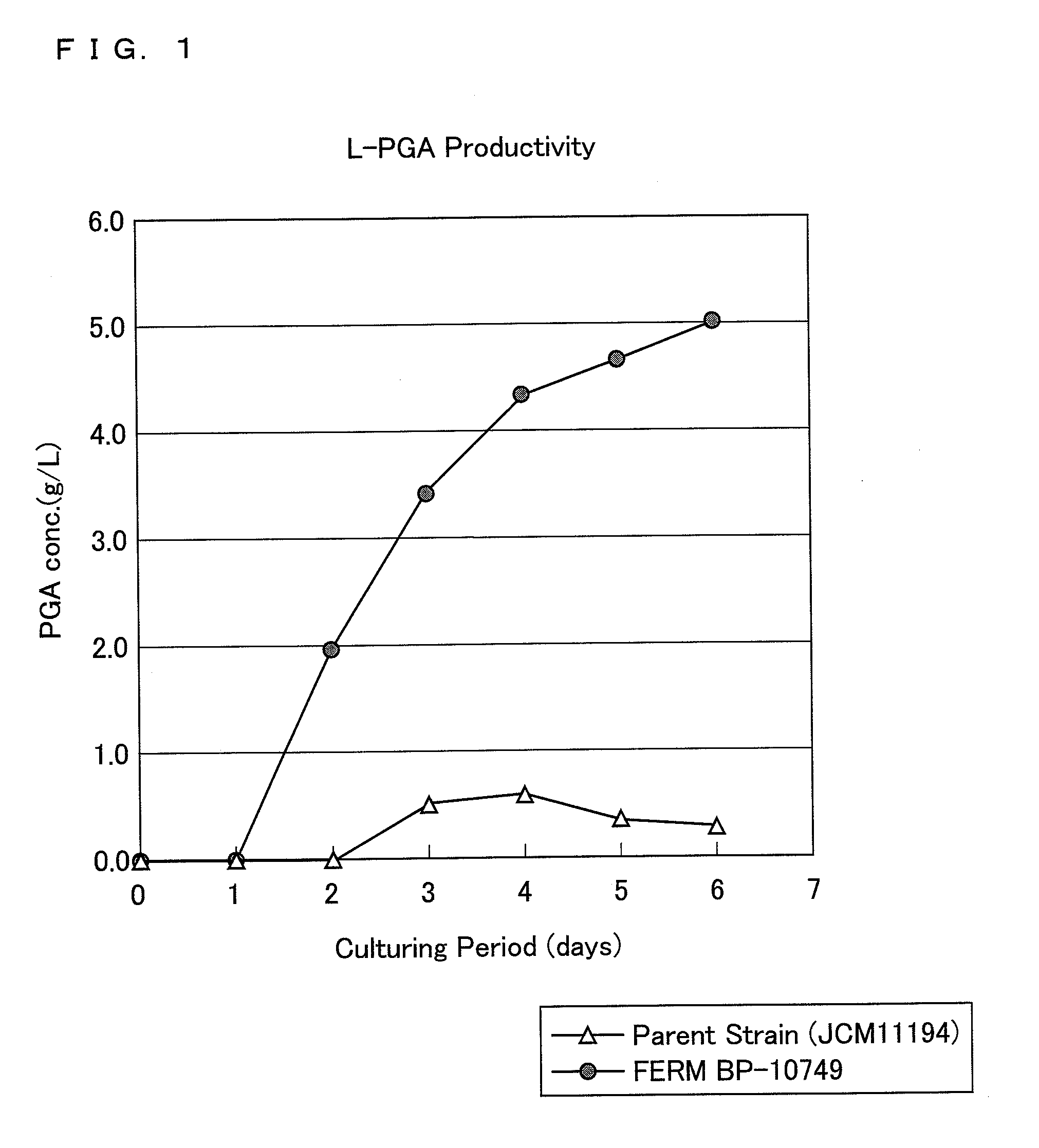Gamma-l-pga producing microorganism, method of producing gamma-l-pga using the microorganism, crosslinked substance produced using the microorganism, and external dermal agent produced using the microorganism
a technology of gamma-l-pga and microorganisms, which is applied in the field of microorganisms, can solve the problems of large obstacle in evaluating the practical use of pga as an alternative raw material, many waste plastics alleged to be threatening ecosystems, and produced from bacillus subtilis var. natto or their analogues, etc., and achieves uniform optical purity, large molecular weight, and large molecular weigh
- Summary
- Abstract
- Description
- Claims
- Application Information
AI Technical Summary
Benefits of technology
Problems solved by technology
Method used
Image
Examples
example 1
NTG Mutagenization Method
[0239]Using an inoculation loop once, a sample was scraped off a single colony of N. aegyptiaca (JCM11194; purchased from the Riken Institute of Physical and Chemical Research). The sample was inoculated on 3 mL of PGA-producing liquid culture medium 1 (22.5% NaCl, 2% MgSO4.7H2O, 0.2% KCl, 3% trisodium citrate, 1% yeast extract, 0.75% casamino acid, pH 7.2) in an 18-mL test tube and cultured at 37° C. and 300 rpm for 3 days. 0.5 mL of the obtained culture solution was inoculated on 50 mL of PGA-producing liquid culture medium 1 in a 500-mL Sakaguchi flask and cultured at 37° C. and 180 rpm for 5 days. The obtained culture solution was then centrifuged for 5 minutes at 3,000 rpm to collect bacteria cells to which a 100 mM buffer solution of citric acid (pH 6.0) was added. The mixture was resuspended. This procedure was repeated 3 times. 70%, 50%, 20%, and 10% NTG solutions, prepared by diluting an NTG-saturated solution (available from Tokyo Chemical Industry...
example 2
Screening for Bacterium Producing Large Amounts of poly-γ-L-glutamate
[0241]A colony obtained under the conditions under which the survival rate is less than or equal to 1% was seeded on PGA-producing agar medium 1 (10% NaCl, 2% MgSO4.7H2O, 0.2% KCl, 3% trisodium citrate, 1% yeast extract, 0.75% casamino acid, 2% agar) and PGA-producing agar medium 2 (22.5% NaCl, 2% MgSO4.7H2O, 0.2% KCl, 3% Trisodium Citrate, 1% yeast extract, 0.75% casamino acid, 2% agar) and cultured at 37° C. for 6 days. After the culturing, a mutant was selected which produced poly-γ-L-glutamate under the culturing conditions in PGA-producing liquid culture medium 1. The obtained mutant was again seeded in PGA-producing agar medium 1 to confirm reproducibility. Using an inoculation loop once, a sample was scraped off a single colony of the mutant of which the reproducibility was confirmed. The sample was inoculated on 3 mL of PGA-producing liquid culture medium 1 in an 18-mL test tube and cultured at 37° C. and 3...
example 3
Comparison of poly-γ-L-glutamate Productivity of Mutants
[0243]Strain 0831-264 (Accession No.: FERM BP-10749), obtained in example 2, and the parent strain (JCM11194) were cultured under the same culturing conditions as in example 2. As illustrated in FIG. 1, FERM BP-10749 exhibited a poly-γ-L-glutamate productivity of 4.99 g / L in the culture solution, whereas the parent strain exhibited a productivity of 0.61 g / L.
PUM
| Property | Measurement | Unit |
|---|---|---|
| pH | aaaaa | aaaaa |
| temperature | aaaaa | aaaaa |
| temperature | aaaaa | aaaaa |
Abstract
Description
Claims
Application Information
 Login to View More
Login to View More - R&D
- Intellectual Property
- Life Sciences
- Materials
- Tech Scout
- Unparalleled Data Quality
- Higher Quality Content
- 60% Fewer Hallucinations
Browse by: Latest US Patents, China's latest patents, Technical Efficacy Thesaurus, Application Domain, Technology Topic, Popular Technical Reports.
© 2025 PatSnap. All rights reserved.Legal|Privacy policy|Modern Slavery Act Transparency Statement|Sitemap|About US| Contact US: help@patsnap.com



